 |
 |

 |
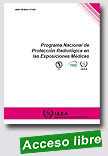 |
Programa Nacional de Proteccion Radiologica en las Exposiciones Medicas
IAEA TECDOC, 2013, 101 p.
La presente guía para la autoevaluación del programa regulador de las exposiciones médicas tiene por finalidad proporcionar al organismo competente un método para evaluar su programa en dicha área y, en consecuencia, facilitar la elaboración de programas reguladores más eficientes que propicien el cumplimiento de los requisitos de protección radiológica en la exposición médica establecidos en las nuevas NBS. |
Extraído de: http://www-pub.iaea.org/MTCD/Publications/PDF/TE-1710_web.pd
|
 |
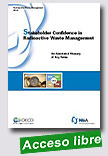 |
Stakeholder Confidence in Radioactive Waste Management - An Annotated Glossary of Key Terms
Nuclear Energy Agency (NEA), 13/05/13, 64 p.
The OECD Nuclear Energy Agency (NEA) Forum on Stakeholder Confidence (FSC) Annotated Glossary is a review of concepts central to societal decision making about radioactive waste management. It records the evolution in understanding that has taken place in the group as the FSC has worked with these concepts over time. This should be a useful resource not only for new FSC participants but also for others: this annotated glossary forms a good reference handbook for future texts regarding societal aspects of radioactive waste management and its governance.
|
Extraído de: http://www.oecd-nea.org/tools/publication?query=&div=&lang=&period=6m&sort=title&filter=1
|
 |
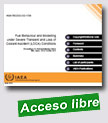 |
Fuel Behaviour and Modelling under Severe Transient and Loss of Coolant Accident (LOCA) Conditions
IAEA TECDOC (CD-ROM), 2013, s. p.
This publication is the proceedings of a technical meeting on fuel behaviour and modelling under severe transient and loss of coolant accidents (LOCA) conditions, hosted by the Japan Atomic Energy Agency. It was attended by 83 nuclear fuel specialists representing fuel vendors, nuclear utilities, research |
and development institutions and regulatory authorities from 19 Member States. The papers submitted to the meeting were organized into seven sessions, covering the areas of analytical and experimental RIA (reactivity initiated accidents) and LOCA studies and international programmes, power ramp and severe accident analysis. These proceedings contain all papers presented and discussed during the meeting, and highlight the key findings and recommendations based on the summaries of the session chairmen.
Extraído de:
http://www-pub.iaea.org/books/IAEABooks/10433/Fuel-Behaviour-and-Modelling-under-Severe-Transient-and-Loss-of-Coolant-Accident-LOCA-Conditions |
 |
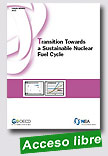 |
Future fuel cycle characteristics, feasibility and acceptability will be crucial for the continued development of nuclear energy, especially in the post-Fukushima context. Fuel cycle choices have both long- and short-term impacts, and a holistic assessment of their characteristics, cost and associated safety issues is of paramount importance. This report seeks to associate quantified impacts with foreseeable nuclear energy development in different world regions. It gives initial results in |
terms of uranium resource availability, fuel cycle facility deployment and reactor types. In particular, the need to achieve short doubling times with future fast reactors is investigated and quantified. The report also provides guidelines for performing future studies to account for a wider range of hypotheses on energy demand growth, different hypotheses regarding uranium resource availability and different types of reactors to be deployed.
Extraído de: http://www.oecd-nea.org/tools/publication?query=&div=&lang=&period=6m&sort=title&filter=1
|
 |
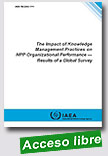 |
The Impact of Knowledge Management Practices on NPP Organizational Performance - Results of a Global Survey
IAEA TECDOC, 2013, 131 p.
The objective of this report is to summarize the findings of research that was conducted as a thesis to explore the link between KM practices and their impact on NPP organizational performance. In general, the issue has not been extensively researched and is not well understood. Little or no prior empirical research has been done on this topic in the specific context of NPP operations. The report also summarizes the |
findings from the research on the importance of a supportive organizational culture, how it is influenced by KM practices, and how it impacts organizational knowledge processes and performance. Finally, the report summarizes the research findings on what specific knowledge management practices have proven effective in NPPs and what benefits have been achieved in terms of organizational effectiveness.
Extraído de: http://www-pub.iaea.org/MTCD/Publications/PDF/TE-1711_web.pdf
|
 |
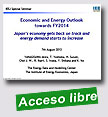 |
Economic and Energy Outlook towards FY2014 - Japan’s economy gets back on track and energy demand starts to increase
Institute of Energy Economics (Japan), August 2013, 21 p.
Greater investment in nuclear regulation will pay dividends for Japan as it moves to restart nuclear reactors. Mobilising more safety review teams could save the country ¥850 billion ($8.8 billion) if it means more reactors can restart sooner.
|
The figure comes from the Institute of Energy Economics, Japan (IEEJ), which published an outlook to FY2014 taking nuclear restarts into account along with many other economic factors, including effects of the 'Abenomics' policies of prime minister Shinzo Abe.
Applications for ten reactor restarts were submitted by utilities as soon as the Nuclear Regulation Authority finalised its requirements in July.
The IEEJ expects the Nuclear Regulation Authority to conduct restart safety assessments using three main teams as well as a specialist earthquake team and a tsunami team. Staff assigned to those are to number about 80. Taking 6-12 months for each assessment, it is assumed that a maximum of six reactors at three power plants can be processed at a time.
This relates to a 'mid-level case' for restarts where 80 staff take six months per assessment and six reactors come back online by the end of FY2013 (April 2014) and 16 reactors at the end of FY2014. Under this scenario, Japan would be expected to cut the use of oil for electricity generation. Coal would remain steady at levels slightly above those seen before the Fukushima accident but gas will continue to grow, reaching usage some 26% higher than before the nuclear accident.
Accelerating the process by assigning 160 staff to reviewing utility restart applications instead of 80 would cost an extra ¥3.2 billion ($33 million) said the IEEJ. However, it could result in 28 reactors operating instead of 16 and avoid "an outflow of national wealth worth ¥850 billion ($8.8 billion)." The main component of the savings relates to imported fossil fuel, which would come with the additional benefits of avoiding 34 million tonnes of CO2 emissions for FY2014. This would mean the first cut in national emissions in five years, said IEEJ, down from a historic high in FY2013 but still 16% above 1990 levels.
The IEEJ put a figure of 2.7% on economic growth during FY2013, expecting this to continue into FY2014 at a lower rate of 0.8%. After three years of energy saving, this will push electricity demand up by 1.3%.
Report
Extraído de:
http://www.world-nuclear-news.org/RS_National_incentive_for_nuclear_regulation_0908131.html
|
 |
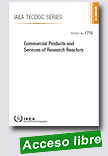
|
Commercial Products and Services of Research Reactors
IAEA TECDOC, 2013, 44 p.
The purpose of this TECDOC is to provide guidance related to the potential of nuclear research reactors (RRs) for supplying products and services such as radioisotope production, education and training or application targeted measurements with reactor based nuclear techniques. Technical and organizational aspects for such services are discussed in some detail, as well as the relevant reactor size or characteristics, including identification of some major requirements and |
constraints. Through a number of individual technical papers, concrete examples are given of opportunities and strategies for organizing commercial services using RRs of different types and various power ratings.
Companion CD
Extraído de: http://www-pub.iaea.org/MTCD/Publications/PDF/te-1715_web.pdf
|
 |
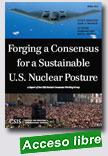 |
Forging a Consensus for a Sustainable U.S. Nuclear Posture
Center for Strategic and International Studies (CSIS), Apr 25, 2013, 88 p.
This report was produced by the CSIS Nuclear Consensus Working Group (NCWG) to assist the Obama administration in forging, during its second term, an enduring consensus about the U.S. nuclear posture. The report includes (1) seven individual statements from nuclear thinkers and practitioners across the “broad middle” of the spectrum of opinion on the role and value of U.S. nuclear weapons, the U.S. nuclear posture needed for |
this defined role, and a political strategy for sustaining the recommended posture; (2) a consensus statement signed by eight members of the NCWG; (3) A description of the process used by the NCWG to forge the signed statement, which includes the lessons learned from the facilitation process; and (4) A case study covering 2008-2012, which provides both a chronology of past attempts to broker consensus about the U.S. nuclear posture and the working group’s assessment of the lessons learned.
Extraído de:
http://csis.org/publication/forging-consensus-sustainable-us-nuclear-posture-0
|
 |
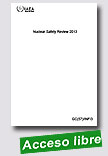 |
Nuclear Safety Review 2013
IAEA, July 2013, 62 p.
The Nuclear Safety Review 2013 focuses on the dominant nuclear safety trends, issues and challenges in 2012. The Executive Overview provides crosscutting and worldwide nuclear safety information along with a summary of the major sections covered in this report. Sections A–E of this report cover improving radiation, transport and waste safety; strengthening safety in nuclear installations; improving regulatory infrastructure and effectiveness; enhancing emergency preparedness and
|
response (EPR); and civil liability for nuclear damage. The Appendix provides details on the activities of the Commission on Safety Standards (CSS), and activities relevant to the IAEA Safety Standards.
Extraído de:
http://www.iaea.org/About/Policy/GC/GC57/
GC57InfDocuments/English/gc57inf-3_en.pdf
|
 |
|
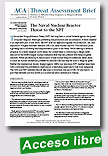
|
The Naval Nuclear Reactor Threat to the NPT
Arms Control Association, July 24, 2013, 8 p.
Preventing the production and accumulation of fissile material is an important objective of nuclear nonproliferation efforts. Unfortunately, the nuclear Nonproliferation Treaty (NPT) exempts the fuel used in naval propulsion reactors from the constraints the treaty otherwise applies to enriching uranium beyond the levels used in civilian power reactors. As the number of countries with nuclear-powered submarines expands, this exclusionposes a growing risk to achieving the nonproliferation goals of the treaty.
|
The United States and Britain are both poised to make long-lasting decisions on replacements for current classes of nuclear ballistic missile submarines that use weapons-grade uranium in their reactors. Brazil, meanwhile, has become the first NPT non-nuclear-weapon state to begin building a nuclear-powered submarine. The reactor designs chosen by these three countries and the degree to which the IAEA attempts to regulate the production, use, and disposition of naval reactor fuel are likely to influence global attempts to rein-in uranium enrichment in states of proliferation concern like Iran.
Extraído de:
http://www.armscontrol.org/threats/The_Naval_Nuclear_Reactor_
Threat_to_the_NPT?utm_source=NSSPI+News+Digest&utm_
campaign=127d39fb6d-RSS_EMAIL_CAMPAIGN&utm_medium=
email&utm_term=0_d96553fdd0-127d39fb6d-51249257
|
| |
|
|
| |
| |
|
|
|
| |
|
|
|
| |
|
|
|
| |
|
